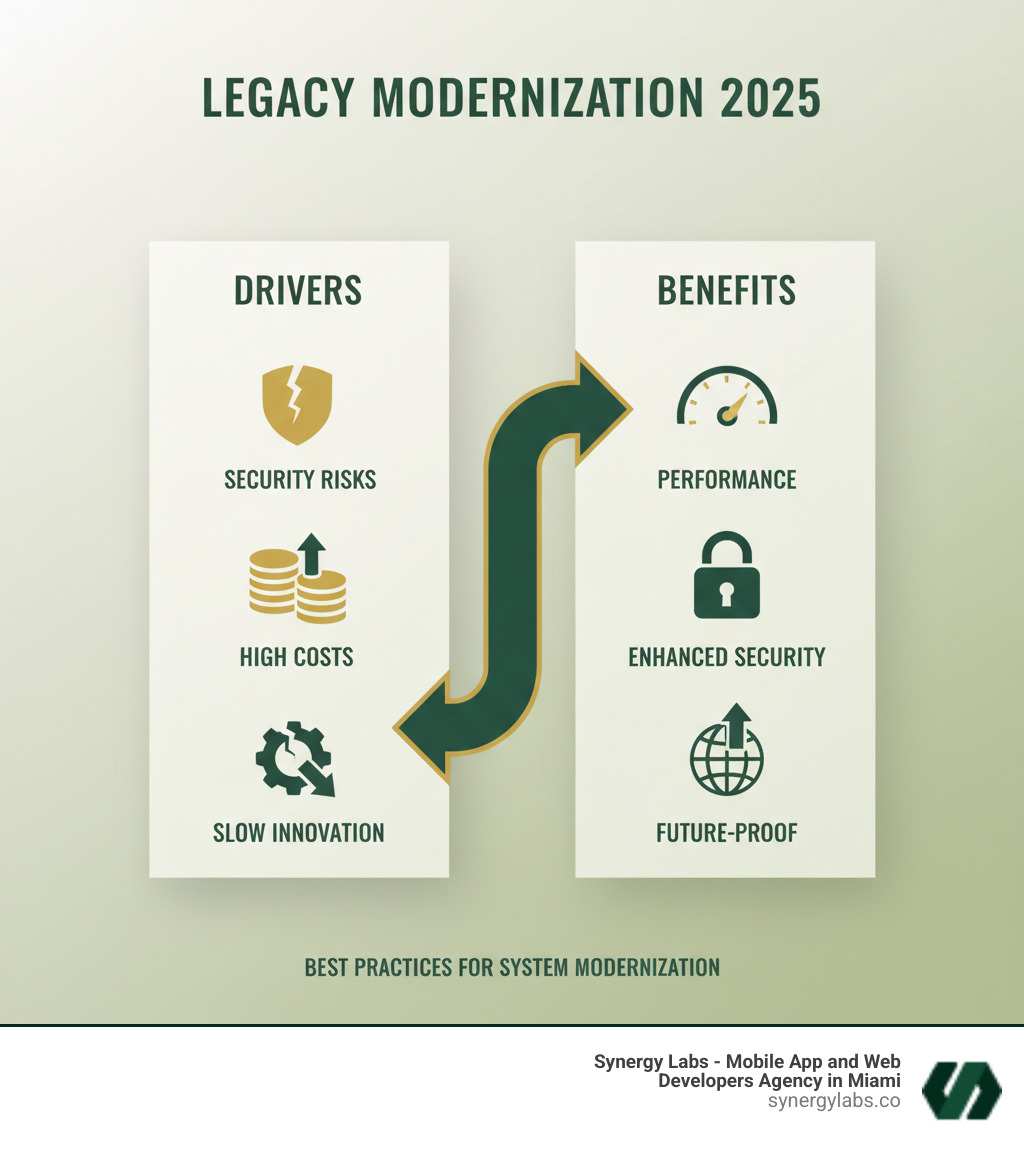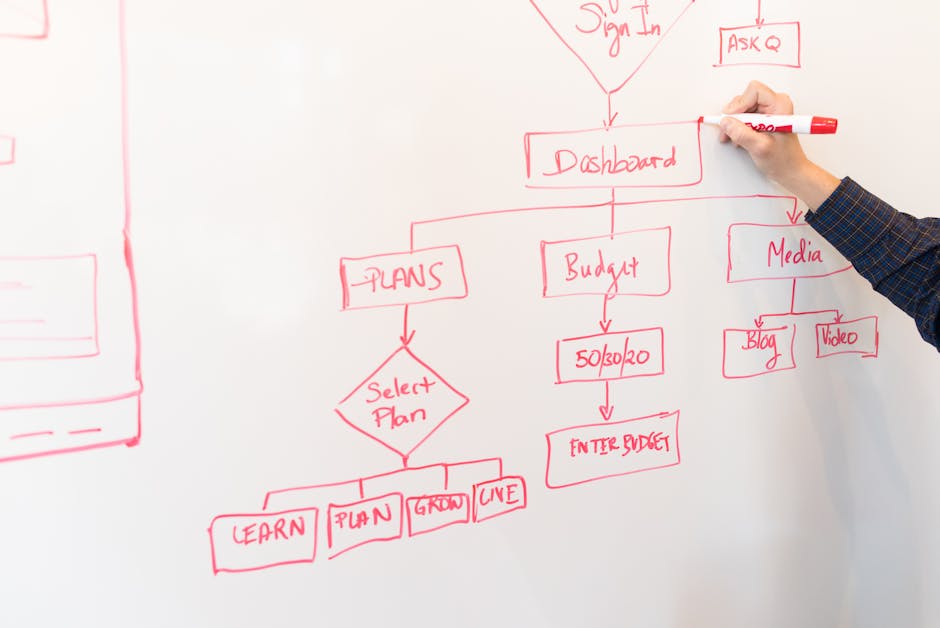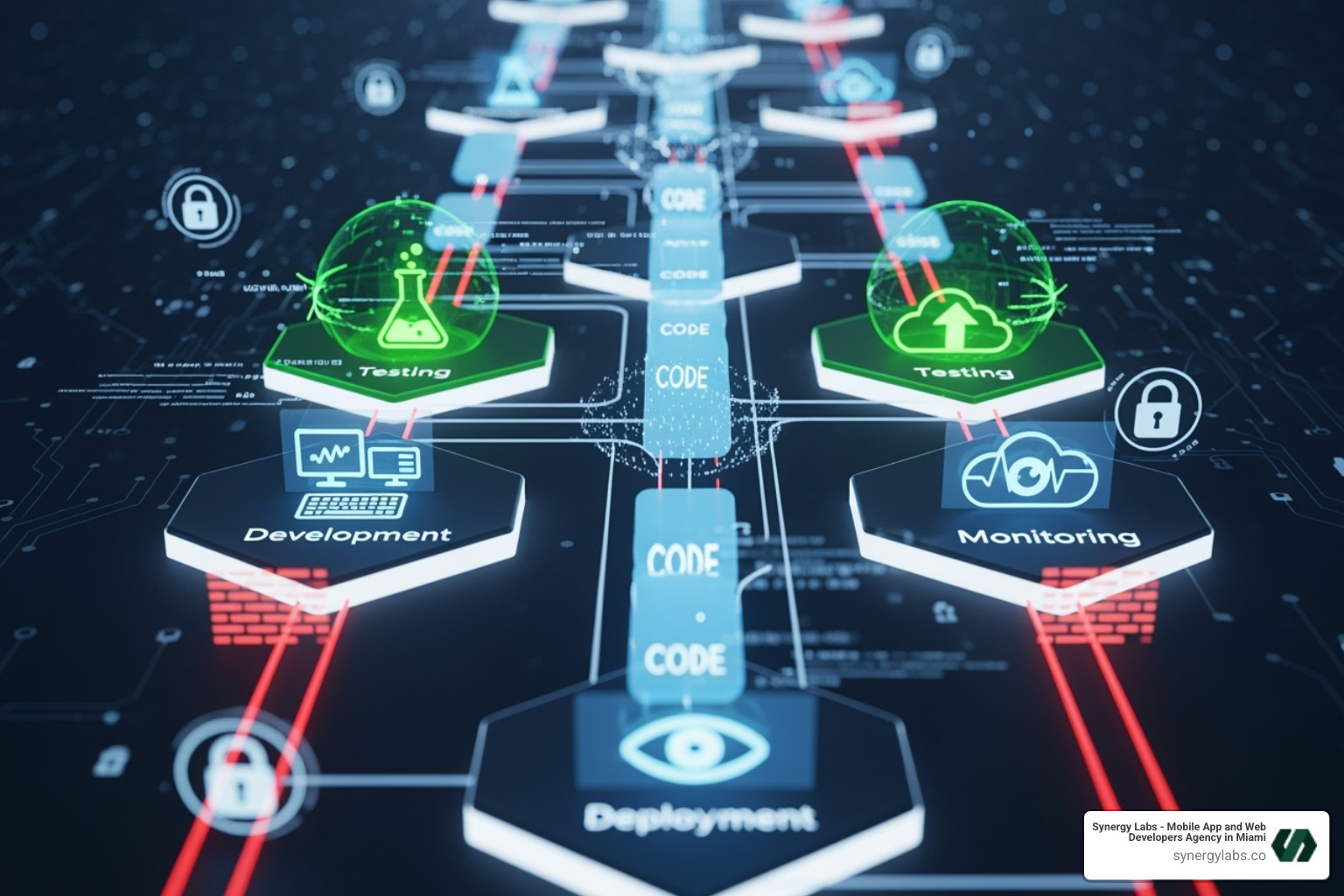Partner with a TOP-TIER Agency
Schedule a meeting via the form here and
we’ll connect you directly with our director of product—no salespeople involved.
Prefer to talk now?
Give us a call at + 1 (645) 444 - 1069
"These no longer optional, they're essential for business' survival."

Best Practices for Legacy System Modernization in 2025 are no longer optional, they're essential for business' survival. If you're running outdated technology, you're facing mounting costs, security risks, and an inability to compete. Here's what you need to know:
Quick Answer: Top Best Practices
Legacy systems are like trying to stream a blockbuster on a VHS player. They worked once, but now they're holding you back. These outdated applications create real problems: security vulnerabilities, maintenance costs that can consume 70% of an IT budget, and an inability to integrate with modern tools like AI or cloud platforms.
The pressure is real. According to industry research, 90% of applications will be cloud-native by the end of 2025. Meanwhile, a staggering 79% of app modernization projects fail because companies rush in without a plan. The stakes are high: fail to modernize, and you risk system failures, compliance violations, and losing ground to competitors.
But when done right, modernization transforms your IT from a cost center into a competitive advantage. You gain speed, security, scalability, and the ability to innovate. Companies that modernize can see 30% lower operational costs, faster time-to-market, and happier teams who don't have to wrestle with ancient code.
As a team at Synergy Labs, we've helped startups and mid-sized enterprises steer Best Practices for Legacy System Modernization in 2025, from initial assessment through deployment and beyond. We've seen how the right strategy—whether it's a Strangler Fig pattern or a full cloud migration—can turn a technical liability into a business driver.

Simple guide to Best Practices for Legacy System Modernization in 2025 terms:
Think of modernizing your legacy systems like renovating an old house while you're still living in it. You need a clear plan before you start tearing down walls. That's why every successful modernization journey starts with a thorough assessment and a clear roadmap.
A sobering reality: 79% of app modernization projects fail, often because companies skip the planning phase. They underestimate complexity, overlook dependencies, or choose the wrong strategy. At Synergy Labs, we've learned that the difference between success and failure is a phased approach with clear, measurable objectives.
The pressure to modernize is intense. Security teams worry about vulnerabilities, CFOs want to cut maintenance costs, and product teams need to integrate modern tools. When you assess properly, modernization becomes a strategic advantage, delivering business agility, cost savings, improved security to meet regulations like GDPR, better performance, and improved user experiences.

Before writing any code, we must understand the existing environment. This assessment phase is critical for success.
To make this actionable, we leverage industry-standard IT assessment frameworks to create a realistic roadmap for improvement.
Modernization is hard, but understanding common challenges upfront allows us to build effective strategies.
By addressing these challenges proactively, we set the foundation for a successful modernization journey. For a deeper look, check out our The Definitive Guide to Digital Transformation Services for Mid-Sized Enterprises in 2025.
Once we've mapped your current landscape, the next step is choosing the right modernization strategy. There's no one-size-fits-all solution; it's a balance of risk, cost, and time, guided by your business objectives.
Think of it like deciding what to do with an old house. Do you renovate, add an extension, or tear it down and rebuild? Each choice makes sense in different situations, and the same is true for your legacy systems.

The key is to align the technical approach with your business goals. Sometimes a simple lift-and-shift is enough, while other times a complete rebuild is necessary. For more insights on building enterprise solutions, see The Complete Guide to App Development for Enterprise Solutions in 2025.
The industry framework of the 7 R's provides a clear way to think through your options. These strategies, adapted from models by industry leaders, give us a clear menu of options.
Beyond the 7 R's, two architectural patterns are our go-to approaches for reducing risk in complex modernizations.
The Strangler Fig Pattern involves building new functionality around your legacy system, gradually routing traffic to new services until the old system is fully replaced and can be retired. This incremental approach avoids a risky "big bang" cutover and ensures business continuity. We used this pattern to help a law firm replace its client management system with zero downtime.
The API-First approach involves wrapping a legacy system's core functionality in modern APIs. This decouples the old system, allowing new applications to access its data and logic without touching the legacy code directly. We helped a financial institution use this pattern to build a modern mobile app on top of its core banking platform. Following API Design Best Practices is critical for success.
Both patterns, central to our approach at Synergy Labs, allow us to deliver value incrementally while minimizing risk. When combined with the right strategy from the 7 R's, you get a practical and powerful modernization plan. If you're curious about how custom solutions can give you an edge, check out How Custom Software Solutions Can Give Your Startup a Competitive Edge.
Choosing a strategy is just the beginning; execution is where the real challenge lies. Successful modernization is about steady progress, constant learning, and an unwavering focus on delivering value. We need to keep your business running smoothly while we rebuild your technology foundation piece by piece.

Embracing modern technology is about open uping new capabilities that can fundamentally change how your business operates.
Technical excellence must be paired with strategic decisions to ensure success.
Modernization isn't a one-time project; it's a continuous process of adaptation. At Synergy Labs, we focus on building an ecosystem that can evolve with your business, ensuring you can respond quickly to the next big technology shift without another massive overhaul.

This mindset of continuous improvement is what separates companies that thrive from those that play catch-up. The Best Practices for Legacy System Modernization in 2025 are about building agility into your DNA. For a broader view of where mobile technology is heading, check out our insights on Top 5 Trends in Mobile App Development.
Several key trends are reshaping how we approach modernization:
To understand how these fit into the broader technology landscape, our article on Top Software Development Trends Shaping 2024: What You Need to Know provides valuable context.
Knowing if your modernization succeeded requires delivering measurable business outcomes over time.
Future-proofing isn't about predicting the future; it's about building systems flexible enough to adapt when it arrives. For insights into how specialized partners can support this journey, read Why Businesses Should Choose Boutique App Development Agencies for Scalable Solutions.
We often encounter similar questions from our clients about legacy system modernization. Here are some of the most common ones:
Think of it like renovating a building. Refactoring is like improving a room's interior design—you restructure existing code to improve its quality and maintainability without changing what it does externally. Re-architecting is like changing the building's blueprint—you significantly alter the application's core structure, often to improve scalability (e.g., moving from a monolith to microservices) or enable new capabilities.
The timeline varies widely based on system complexity, the chosen strategy, and team size. A simple rehosting might take a few months, while a full re-architecture or replacement of a large, critical system can span one to three years. We recommend a phased approach that delivers value incrementally along the way.
The biggest risk is a cascade of negative consequences that cripples your organization. It starts with increased security vulnerabilities and system failures, leading to exorbitant maintenance costs that stifle innovation. This inability to adapt and compete results in a loss of market share and threatens your business's long-term survival and growth. Not modernizing turns your IT into a liability instead of a competitive asset.
Modernizing your legacy systems is a fundamental shift that can define your organization's future. It's not just an IT project; it's a strategic imperative for innovation, agility, and growth. The companies that thrive will be those who made smart, strategic decisions about modernization.
Successful modernization boils down to a few key principles:
At Synergy Labs, we've guided many organizations through this journey. We combine technical expertise with a deep commitment to your business goals. With direct access to senior talent and a focus on user-centered design, we don't just modernize systems; we help you build the agile IT foundation your business needs to compete and win.
Your legacy systems tell the story of where you've been. Modernization writes the story of where you're going.
Ready to transform your legacy systems from anchors into engines of growth? Explore our custom software development services and let's build your competitive advantage together. The future doesn't wait and neither should you.

Getting started is easy! Simply reach out to us by sharing your idea through our contact form. One of our team members will respond within one working day via email or phone to discuss your project in detail. We’re excited to help you turn your vision into reality!
Choosing SynergyLabs means partnering with a top-tier boutique mobile app development agency that prioritizes your needs. Our fully U.S.-based team is dedicated to delivering high-quality, scalable, and cross-platform apps quickly and affordably. We focus on personalized service, ensuring that you work directly with senior talent throughout your project. Our commitment to innovation, client satisfaction, and transparent communication sets us apart from other agencies. With SynergyLabs, you can trust that your vision will be brought to life with expertise and care.
We typically launch apps within 6 to 8 weeks, depending on the complexity and features of your project. Our streamlined development process ensures that you can bring your app to market quickly while still receiving a high-quality product.
Our cross-platform development method allows us to create both web and mobile applications simultaneously. This means your mobile app will be available on both iOS and Android, ensuring a broad reach and a seamless user experience across all devices. Our approach helps you save time and resources while maximizing your app's potential.
At SynergyLabs, we utilize a variety of programming languages and frameworks to best suit your project’s needs. For cross-platform development, we use Flutter or Flutterflow, which allows us to efficiently support web, Android, and iOS with a single codebase—ideal for projects with tight budgets. For native applications, we employ Swift for iOS and Kotlin for Android applications.




For web applications, we combine frontend layout frameworks like Ant Design, or Material Design with React. On the backend, we typically use Laravel or Yii2 for monolithic projects, and Node.js for serverless architectures.






Additionally, we can support various technologies, including Microsoft Azure, Google Cloud, Firebase, Amazon Web Services (AWS), React Native, Docker, NGINX, Apache, and more. This diverse skill set enables us to deliver robust and scalable solutions tailored to your specific requirements.








Security is a top priority for us. We implement industry-standard security measures, including data encryption, secure coding practices, and regular security audits, to protect your app and user data.
Yes, we offer ongoing support, maintenance, and updates for your app. After completing your project, you will receive up to 4 weeks of complimentary maintenance to ensure everything runs smoothly. Following this period, we provide flexible ongoing support options tailored to your needs, so you can focus on growing your business while we handle your app's maintenance and updates.